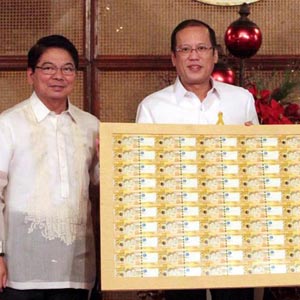MANILA (PinoyNews) – The Bangko Sentral ng Pilipinas (BSP) has attracted plaudits and criticisms for its newly launched peso bills.
Groups said the bills contain geographical errors and violate basic naming conventions in taxonomy, but President Aquino himself defended the BSP, pointing out that the new bills are not maps.

Another group said the bills will promote the Philippines as a tourist attraction as they feature top tourist attractions like the Palawan underground river, the Bohol Chocolate Hills, and the world-famous Tubbataha Reefs, among others.
But the location of the Tubbataha Reefs in the P1,000 bills was “a glaring mistake” as it has been positioned nearer to Malaysia.
The web site New Media Press Headquarters also complained that the Puerto Princesa underground river in the P500 bill appeared to be inland. The Philippine map in the new peso bills also cropped out the Batanes islands, one of the best places in the country.
Alain del Pascua, president of Kaakbay, decried the use of the Leyte landing and so-called American liberation, saying the gallant Filipino soldiers who fought the Japanese forces should been there instead.
Pascua also said that the Coat-of-Arms of the Republic of the Philippines was erroneously referred to by BSP as “Seal of the President” in all its descriptions of the new banknotes.
“Why is the Bald Eagle of the United States of America and the Lion-Rampant of Spain (the Charge of the Kingdom of Leon) included in the depiction of the Coat of Arms of the Republic of the Philippines when these symbols and representation of colonial history are no longer mentioned in the Flag and Heraldic Code of the Philippines?” he asked.
The Akbayan head proposed a new series depicting other Philippine heroes, other Philippine presidents, and national symbols like the evolution of the Philippine Flag, the Lupang Hinirang, the Philippine Eagle, Sampaguita, Narra, Anahaw, Mango Tamaraw, Arnis, Sipa, etc.
The central bank was also criticized for allegedly violating naming conventions in taxonomy.
By convention, the scientific name is italicized and consists of two words, the generic name (genus) followed by the specific name (species), with the first starting with a capital letter and the second with a lowercase letter to show the heirarchy between the two.
Another group said the beak of the extinct Philippine parrot in the bill is yellow and not red.
It was not the first time errors have found their way into the Philippine currency. In 2005, the central bank released new P100 bills that misspelled then President Gloria Arroyo’s name as “Arrovo.”
The bills, 2 million pieces of which were released for circulation, are still legal tender and are now considered collector’s items.
The European printer that printed the “Arrovo” bills, Oberthur Technologies, is also the printer of the new peso bills.



 ShareThis
ShareThis